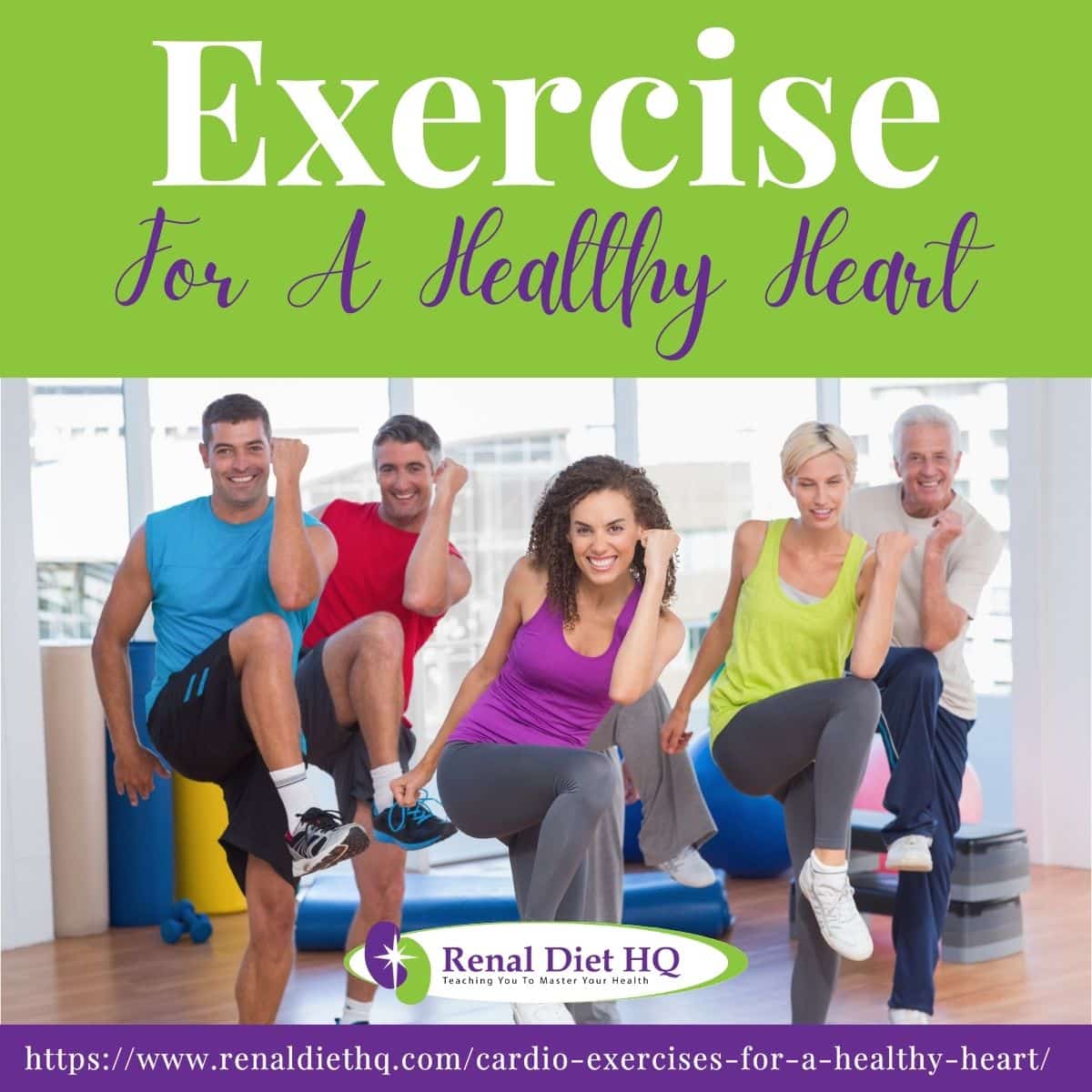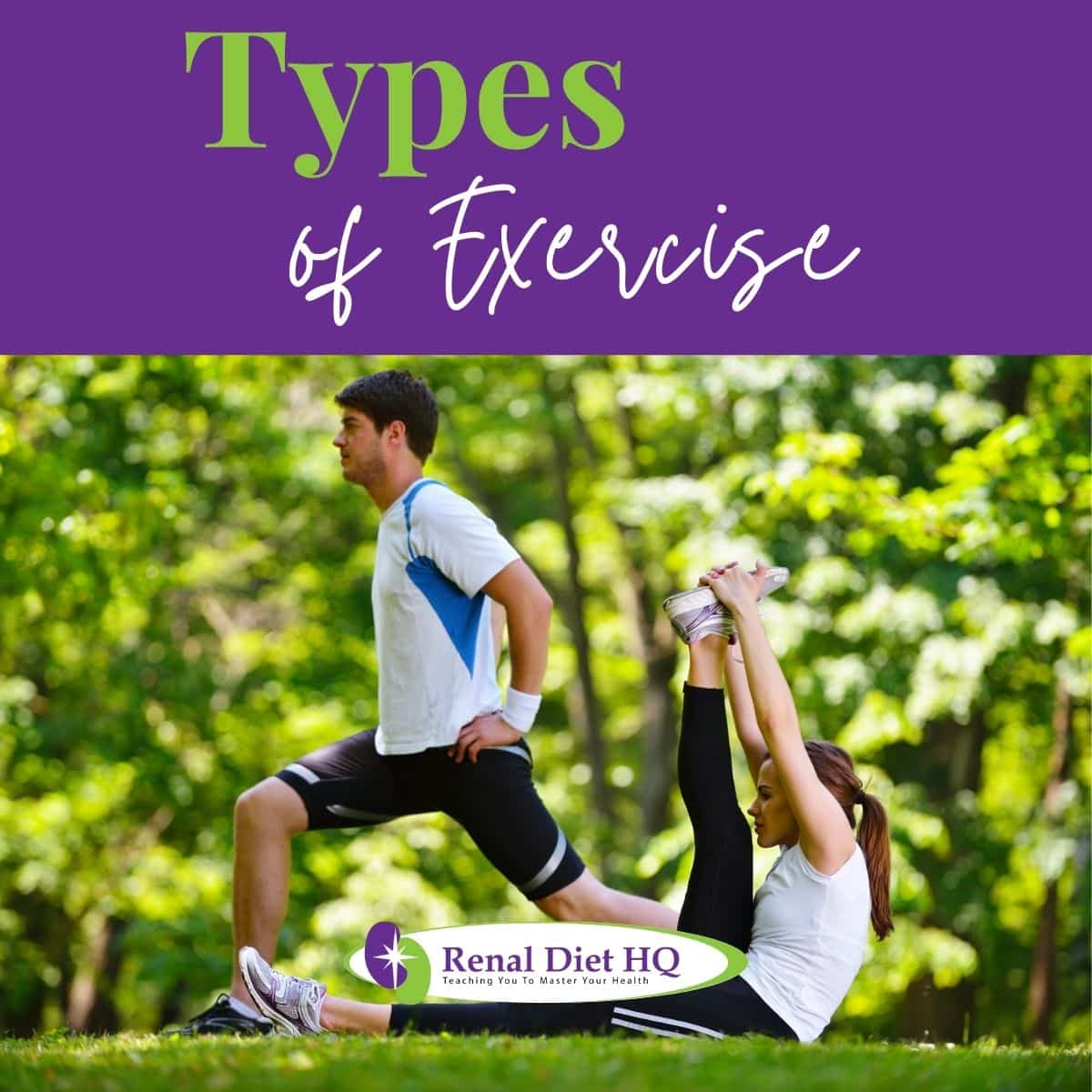Exercise For Healthy Heart
Are you looking for ways to keep your heart healthy? Exercise is a great way to do just that! It strengthens the heart and improves circulation, reducing the risk of heart disease. You are about to start making heart healthy lifestyle changes for CKD.
Plus, it can even help those with chronic kidney disease (CKD). Like a soothing balm on an open wound, regular exercise can help CKD patients manage their symptoms and lead healthier lives.

In this article, we'll explore all the benefits of exercising for those living with CKD, as well as give you some advice on getting started. Read on to learn more about how exercise can benefit your heart health!
Jump to:
How Do I Exercise With Chronic Kidney Disease?
Exercise can be an important part of managing your CKD, so it's essential to talk to your doctor before beginning any routine.
Low-impact exercises like walking and swimming are beneficial for CKD patients as they support weight loss,improve blood circulation, and can help you manage high blood pressure. Walking is great for strengthening the heart and managing a healthy weight, while swimming helps with strength training.
It's also important to consult with your doctor before starting more strenuous activities like jogging or aerobics classes which help get the heart pumping and hold you accountable for exercise.
It's essential not to overdo any activity, especially if you've been inactive for a long time. Cardio exercise is key for having a healthy heart but too much could increase risk of complications or even cause injury.
If you are physically fit enough to take on jogging, it can increase your overall cardiovascular fitness, help you build strong bones, and can even lower your risk of chronic diseases. Since jogging burns plenty of calories, you may also lose unneeded weight faster or better maintain your current weight.
Make sure your doctor says it is okay for you to do something more strenuous such as jogging before you begin. Grab a durable pair of running shoes to lessen the pain of exercise, and consider carrying small weights on your jog to work your arms too.
Resistance training helps reduce body fat, create leaner muscle mass and raise good cholesterol levels while reducing bad cholesterol levels.
Flexibility workouts such as basic stretches or yoga are also recommended every day in order to stay flexible. Better flexibility can help decrease your risk of injuries and enable your muscles to work more effectively when exercising.
Exercise should always be done under medical supervision since there may be warning signs that require seeking medical attention such as chest pains or shortness of breath during exercising sessions.
For More Recipes and Ideas --->> Get Your Free Meals and Recipes That Are Perfect for Pre-Dialysis Diets, Pre-Dialysis with Diabetes, or Dialysis Diets.

Heart Healthy Tips
Pump up your heart's power and protect yourself from cardiovascular complications with regular, low-impact activities, they're a sure way to keep your ticker ticking!
Exercise is an important part of staying healthy with CKD. However, it's important to take precautions before beginning any exercise routine. Consult with your doctor first, especially if you've been inactive for a long time.
Here are the basic steps for exercising safely and effectively:
1. Frequency: Aim for at least 30 minutes per session and 3 sessions per week of aerobic activity.
2. Intensity: Start slow and gradually increase intensity or duration as you become more fit.
3. Duration: Allow time for warming up before starting the workout and cooling down afterwards.
4. Results: See results over time in terms of improved circulation, lower blood pressure, reduced type 2 diabetes risk, better blood glucose control, increased lean muscle mass, lowered body fat and improved HDL (good) cholesterol levels while lowering LDL (bad) cholesterol levels.
It's vital to not overdo any activity, remember that even 30 minutes of brisk walking each day can make a significant difference in improving heart health! Low-impact exercises such as walking or swimming are great ways to improve your circulation without putting too much strain on the body.
Jogging or aerobics classes can be a great way to get your heart pumping and hold yourself accountable for regular exercise sessions.
Following these tips will ensure that you remain healthy while reaping all the benefits of exercise!
Heart Benefits
Exercising regularly can help lower your risk of heart disease, so make sure to take steps to keep yourself in tip-top shape! There are many lifestyle changes that you can make to prevent and manage the risks associated with heart disease.
Taking preventative measures such as regular exercise, eating a balanced diet, reducing stress levels, avoiding smoking and drinking alcohol responsibly are all important factors in maintaining good cardiovascular health.
Making positive lifestyle changes is key when it comes to preventing heart disease. Exercise should be incorporated into your daily routine; aim for at least 30 minutes of moderate physical activity every day. This could include walking, jogging, swimming or cycling, whatever makes you feel comfortable and gives you pleasure!
Eating a nutrient rich diet filled with fruits, vegetables and whole grains will provide your body with the energy it needs for exercise while helping reduce cholesterol levels. Additionally, reducing stress levels by engaging in calming activities like yoga or meditation can help lower blood pressure while also reducing your risk of CKD and stroke..
Finally, quitting smoking or avoiding tobacco products altogether as well as limiting alcohol intake is essential for keeping your heart healthy. While these may seem like small changes, they can make a huge difference when it comes to managing risk factors associated with developing cardiovascular diseases!
| Risk Factor | Prevention/Management |
| High Cholesterol Levels | Eat Nutrient Rich Diet Filled With Fruits Vegetables & Whole Grains To Lower Cholesterol Levels |
| Stress Levels | Reduce Stress Through Calming Activities Like Yoga Or Meditation To Help Lower Blood Pressure & Ease Tension In Body And Mind |
| Smoking/Tobacco Use | Avoid Tobacco Products Altogether To Keep Heart Healthy |
| Alcohol Intake | Limit Alcohol Intake For Keeping Heart Healthy |
Getting Started
What are the benefits of exercising and benefits of a renal diet? Getting your body moving is an important part of staying fit and feeling your best. Exercise can help to improve heart health, but it's important to start slowly and progress gradually.
To ensure success, it's wise to consult with a doctor before beginning any exercise program, as well as to learn proper form for all activities.
Here are some tips for motivation, proper form, progress tracking, equipment needs, and safety precautions when starting an exercise routine for better heart health.
Tips for Motivation: Set realistic goals that are achievable and measurable so you can track your progress. Find a partner or join a class or group activity if you need more accountability and support. Make sure the activity is something you enjoy doing; this will make it easier to stick with the program.
Proper Form: If using weights or other strength-training equipment, use correct technique to avoid injury while reaping maximum benefits from the workout. Consider hiring a personal trainer who can provide instruction on proper form and offer personalized advice about what exercises work best for you based on your current fitness level.
Progress Tracking: Keep records of each session including type of activity performed, amount of time spent exercising per session, intensity levels achieved during each session (such as target heart rate range), etc., so that changes in performance can be monitored over time.
Equipment Needs: Having access to appropriate equipment makes exercising more convenient and enjoyable; consider investing in quality gear such as comfortable shoes designed specifically for the type of exercise being done (running shoes versus cross trainers). Be sure to have water available during workouts; dehydration could affect safety while exercising.
Safety Precautions: It's essential that proper warm up/cool down routines be followed prior/post workout sessions respectively to prevent injuries resulting from sudden changes in temperature/activity levels within the body. Finally, stop immediately if chest pain, dizziness, or difficulty breathing occurs so medical attention can be sought out right away.

Types of Exercise
Still curious about exercise for ckd patients? To stay in shape and keep your body functioning its best, it's important to incorporate a variety of exercises into your routine. Aerobics, resistance training, and flexibility workouts are key components for a well-rounded fitness plan that will have you feeling like the cat's meow.
Aerobic Exercise:
- Exercise Intensity: Improves circulation, lowers blood pressure and heart rate, and increases overall aerobic fitness. Ideal for aerobic exercise is at least 30 minutes a day, at least three days a week.
- Duration Options: Examples of heart-pumping aerobic exercise include brisk walking, running, swimming, cycling, playing tennis, and jumping rope.
- Equipment Required: None or minimal equipment required depending on the type of activity chosen.
- Pre-Workout Fuel: It's best to eat 2–3 hours before working out so as not to slow down performance or slow down your recovery and give your body adequate time to absorb nutrients. It's recommended that your pre-workout meal should contain a balance of protein, carbs, and fats.
- Post-Workout Recovery: A post-workout meal within 45 minutes after your exercise containing a balance of protein, carbs, and fats is also recommended for post-workout recovery.
Resistance Training:
- Exercise Intensity: Helps reduce body fat, raise HDL (good) cholesterol, and lower LDL (bad) cholesterol, and prevents muscle weakness, which is why it’s particularly important for CKD patients. Recommended at least two or three days per week.
- Duration Options: Examples of resistance training include free weights, weight machines, resistance bands, push-ups, squats, chin-ups, etc.
- Equipment Required: Depending on what type of equipment is being used, a gym membership or home gym setup may be necessary.
- Pre-Workout Fuel: It's best to eat a balance of protein, carbs, and fats 2–3 hours before working out so as to give your body adequate time to absorb nutrients. .
- Post-Workout Recovery: A post-workout meal within 45 minutes after your exercise containing a balance of protein, carbs, and fats is also recommended for post-workout recovery.
Flexibility Workouts:
- Exercise Intensity: Benefits musculoskeletal health, enabling you to stay flexible, free from joint pain, cramping, and other muscular issues. Recommended every day before or after other exercise sessions.
- Duration Options: Examples include basic stretches, Tai chi, yoga, etc.
- Equipment Required: None needed, but a yoga mat may provide comfort and support depending on the floor surface being worked out on.
- Pre-Workout Fuel: Low-intensity exercises such as yoga make fewer demands on your body, so you can have a light snack or even go without eating.
By including all three types of exercises into your routine, you can develop a strong, healthier body while developing a stronger, more fit cardiovascular system!
With proper fuel, pre- and post-workout nutrition guidelines, and staying motivated you can be well on your way to creating the most effective personalized fitness regimen to achieve your physical goals!
Aerobics
Can kidney disease cause heart problems? Taking part in aerobic activities is a great way to improve your overall physical fitness and reduce your risk of chronic health conditions.
If you have access to local fitness classes, taking aerobics is a great way to get your heart pumping. Though these classes may be too intense for some, most instructors understand that not everyone is at the same fitness level. They promote going at your own pace, so you may stop sooner than other participants.
Contact a local gym to see what classes are offered. Taking this kind of class helps to hold you accountable for exercise, and it can change up your normal activity to prevent boredom.
Aerobics can provide numerous benefits for heart health, including improved circulation, lower blood pressure, and increased HDL (good) cholesterol levels. With this in mind, let's explore the different intensity levels available for aerobic exercises and what equipment may be needed.
In addition to considering intensity levels when selecting an aerobic activity, it's also important to factor in safety precautions. If participating in a class setting or using exercise equipment such as weights or machines, proper form should always be used to prevent injury or fatigue.
Finally, while taking part in any type of exercise program can bring about amazing results for heart health over time, it's recommended that you consult with a doctor before beginning any new routine. This allows them to monitor potential risks associated with your individual condition and adjust accordingly if necessary.
Resistance Training
Resistance training can help you reach your fitness goals faster, with studies showing that it can reduce body fat and increase good cholesterol levels by up to 20%.
Weight training benefits include improved muscle strength and tone, increased bone density, better posture, injury prevention, and improved mood. Proper form is essential when performing resistance exercises for optimal results. This means using slow controlled motion when lifting weights and avoiding jerky movements that can cause injury.
When targeting different muscle groups, it is important to use a variety of exercises to maximize the benefits. Equipment needed for effective resistance training includes free weights such as dumbbells or barbells, weight machines, resistance bands, or even just body weight exercises like push-ups or squats.
Common mistakes made during weightlifting are improper form and using too much weight at once. It's important to start slowly with light weights so that proper technique can be established before increasing the load.
Resistance training has numerous benefits but should always be done safely under the supervision of a doctor or qualified trainer if possible.
Flexibility Workouts
Flexibility workouts can help keep joints free from pain and cramping, providing a solid foundation for more effective aerobic and strength training.
Yoga stretches, Tai chi benefits, and daily stretching routines are all great options to improve flexibility and balance. These exercises also provide joint pain relief while increasing overall mobility.
Many people find that incorporating relaxation techniques into their routine can help reduce stress levels as well. It's important to remember that flexibility workouts should be done every day in order to reap the full benefits. A good way to start is by committing to 10 minutes of stretching each morning or evening before bedtime.
This will help increase range of motion over time and ensure your muscles stay strong and healthy. If you're unsure about how to properly complete these exercises, it may be beneficial to seek professional advice or take classes from a qualified instructor. Doing so will ensure you get the most out of your routine while avoiding any potential injuries.
With dedication and consistency, you can enjoy improved health through regular flexibility workouts! If you get the chance, check out yoga and ckd and see how yoga can help those with Chronic Kidney Disease.
FAQs for Cardio Exercises for a Healthy Heart
Exercising for optimal heart health is an important part of a healthy lifestyle. Aim to get at least 150 minutes of moderate-intensity exercise per week, like walking, swimming, aerobics classes, or interval training.
To add variety and challenge, try yoga or strength training.
Consult your doctor before starting any new exercise routine and remember to warm up and cool down each time you do it.
With the right combination of activities and sensible precautions, you can keep your heart strong and healthy! And yes, there are some exercise mistakes to avoid with ckd.
Exercising is safe for most people with chronic kidney disease.
It is important to start slowly and progress gradually. To be safe, you’ll also want to perform each exercise correctly, move the weight slowly, both when lifting and lowering, and to breathe throughout the movements.
When using weight machines, start at the lowest levels. You can move up to the harder levels as you get stronger and used to exercise. Do this gradually to ensure that your muscles adapt to the exercise.
If you're looking to lose weight, dieting and physical activity are an important part of the equation. Following a healthy diet is key, but don't forget about exercise too!
Walking, running, cycling, and swimming are considered some of the best exercises for weight loss.
Regular physical activity has many cardiovascular benefits, from improving your heart rate to managing stress. It's important to follow the physical activity guidelines set by your doctor and monitor your heart rate while exercising.
Additionally, it's essential to manage stress levels in order to maintain a healthy lifestyle. So don't forget that dieting tips and regular physical activity go hand-in-hand when it comes to achieving weight loss goals safely and successfully.
Exercising regularly is one of the best things you can do for your heart health. According to the National Heart, Lung, and Blood Institute, just 150 minutes a week of moderate-intensity activity like brisk walking can make a significant difference to your heart health.
You should also monitor your heart rate with a fitness tracker and pair that workout routine with healthy nutrition tips and good quality sleep.
Taking these steps will help keep your heart strong and improve overall cardiovascular health.
It's important to be aware of the warning signs of overexertion when exercising for heart health. Signs you may be pushing yourself too hard include dizziness, chest pain, and difficulty breathing.
To prevent overexertion, it's best to monitor your fatigue levels and make sure you're taking time to rest and recover. Stress management techniques like yoga or meditation can also help manage fatigue. Additionally, eating a healthy diet with plenty of hydration is key for maintaining energy levels during exercise.
Interval training is another great way to vary the intensity of your workout and give yourself time to rest in between sets or reps.
Being mindful of these tips while exercising will help ensure that you stay safe and healthy while working on improving your heart health. You can always check out these mindful eating tips for a renal diet to make life even better for yourself!
Exercising Is Great For Your Heart Health
As you approach the finish line of your exercise journey, remember that a healthy heart is within reach. You can come out on top if you make lifestyle adjustments and stick to an appropriate exercise plan.
It may be overwhelming at first, but with hard work and dedication, you'll soon start to see the results of your efforts.
Think of each step forward as one more mile in your race for better health – keep going until you cross the finish line!














